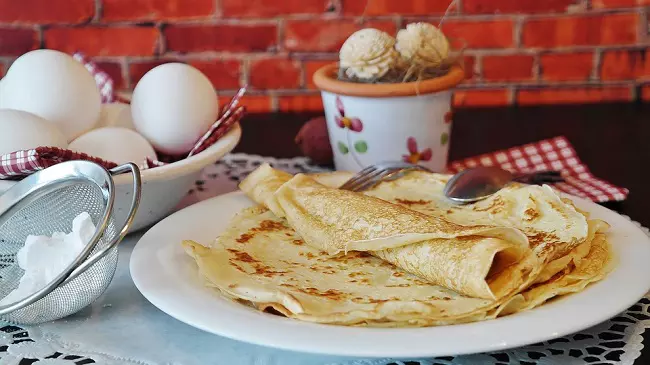How to make sweet, yet perfectly thin crepes?
Many people advice against putting sugar into the batter of the crepes, and if you have ever had to deal with sticky crepe butter and torn crepes, you know why it is a bad idea to sweeten your crepe batter with sugar. Still, using sugar with the right recipe does not result in such a devastating effect, and you can still make pretty and almost paper thin crepes!
Crepes can be served with several kinds of toppings (Photo: pixabay.com / RitaE)
While many people are afraid to put any sugar into the crepe butter due to their fears of the crepes sticking down to the pan or being torn, with the right ratio of the ingredients and a good pan, you'll have no trouble with your pancakes even if you add a bit of sugar to the batter. In fact, these crepes are really easy to handle and flip if you use the ratio of ingredients that we listed below.
Here's what you'll need for making the crepe batter:
1,3 cup of milk
2 medium sized eggs
1,5 cups of flour
3/4 cup of fizzy water
5 tablespoons of oil
4 tablespoons of sugar
A tablespoon of finely grated lemon zest
A pinch of salt
The topping can be just about anything you like, but cinnamon, fruit jam, fresh fruits (such as blueberries, bananas, strawberries and raspberries), hazelnut and chocolate spread, sweetened cocoa powder and vanilla custard are really popular.
And here's how you can prepare your crepes:
First, you'll need to mix the sugar, the eggs and the salt, and than gradually mix these with the milk, and the flour. Make sure to mix it well, so no little lumps remain in there.
Add the remaining ingredients to the batter, and mix it again - it's best if you put the water into the batter in the very end.
Heat a good nonstick pan that you trust over medium heat. You can put some oil into the pan, but usually it is not necessary, especially after the first one or two crepes.
Use a ladle to pour a portion of the batter into the pan, but be careful not to pour in too much. You'll only need an amount that covers most of the pan, and if you add more, the crepes will be too thick. Once you poured the batter into the pan, start to spread it over the surface of it immediately. You'll need to make circular movements with the back of the ladle to achieve this.
If the batter doesn't cover all of your pan, that's not something to worry about; your crepe will still be delicious. And if you accidentally poured too much of the batter in there, you can pour some of it back into your bowl if you're quick enough.
You'll know it's time to turn your pancake when bubbles start to appear on it, and when you can move the crepe while making back-and-forth movements with the pan. Also, you can check the bottom side of the crepe, and when it's golden brown, you can flip it or turn it with the help of a fork or a spatula.
Now cook the other side of the pancake until it also becomes slightly golden brown, then repeat the cooking process until you have no more batter.
Once your crepes are ready, you can serve them the way you like them - fill them with your choice of topping, fold them the way you'd like, and perhaps dust them with some castor sugar, or scoop some ice cream onto them.
Anita Dios
May 2019
